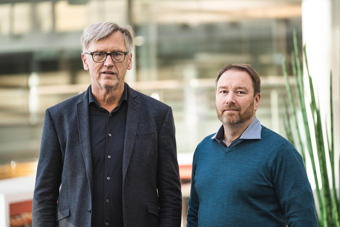
Offshore wind power is a growing sector, which has seen the way Kongsberg Maritime works within it change. Chief Designer Martijn de Jongh explains how we’re keeping pace.
-
Text:Global Sales and Marketing
Photo:©Kongsberg Maritime | ©Nicki Pløk
-
Craig TaylorSenior Manager PR & Communications
One of the major shifts in the past five years in offshore wind is in a more speculative approach to design.
“We approach things differently than we did when the first wind farm vessel tenders came out,” says Chief Designer Martijn de Jongh. “Individual tenders for specific wind farm service contracts aren’t efficient. A lot of time is spent to create the tender-specific documentation. You have multiple bidders for one tender, and there’s only one winner.
“It’s better to develop a project together with a shipowner on speculation and to have vessels already under construction or afloat to offer to the various service tenders. But that requires investment beforehand.
“Vessel specifics can be challenging. If you build for one wind farm, it might be a small vessel. But that might not work for owners sharing assets, or for large wind farms. That’s why we design commissioning service operation vessels (CSOVs) to be usable for other purposes.”

Wind farm operation is one of the few areas where we could achieve net zero emissions.
Keeping pace with the industry
Early wind farm service vessels were created by converting existing vessels. In 2015, the dedicated Service Operation Vessel (SOV) design, UT 540 WP, was developed.

The first dedicated wind farm vessel designed by Kongsberg Maritime was the Edda Passat. This was followed by Edda Mistral for the Race Bank and Hornsea wind farms in the UK. They were well received and are still in use today. There are elements of flexibility, but the basic design remains much the same with the current portfolio.
Data and feedback from those first two ships, collected as part of the EU-funded Nexus research project, also resulted in a new vessel range that implemented new and innovative solutions while maintaining the proven design elements.
“We spent time visualising operation, power consumption and other operational parameters, with a view to increasing efficiency,” says Martijn. “One of the outcomes was the basis for a fully double-ended design with a hybrid power system of which six vessels were contracted in 2021. The Nexus research programme also provided alternative fuel solutions and concepts for fully electric operation.
“Our main operational challenges relate to understanding types of maintenance and turbines, combined with considerations around energy and fuel consumption. We’re now also having to think about floating wind farms. As that technology develops, requirements will change again.”
The Edda Mistral was the second vessel of its kind to be designed by Kongsberg Maritime.
Future-forward fuels
As with all Kongsberg Maritime operations, ship design for CSOVs and SOVs must consider sustainable fuel and energy systems. That brings its own challenges.
Even a fuel like methanol, already a known product, comes with uncertainties, with suppliers, regulators and equipment designers working at different speeds. Nonetheless, says Martijn, it’s a good crossover.
“You can convert, or plan to convert, to methanol without too many problems,” he notes. “You can also clean the tanks and use them for diesel. Other alternative fuels present more difficulties.
“Ammonia, LNG, biogas and hydrogen all need special tankage that can’t be used for anything else. Added to that, the application of each fuel for each vessel type can be very different. Certain vessels might be able to use ammonia or hydrogen, on others the compromises needed are just too great. But technology development may bring new opportunities. It requires a constant technology watch.”
One of the major developments in offshore wind service operations, however, is the potential for battery-powered vessels that can be charged offshore. Nexus showed the technology is feasible.
“Wind farm operation is one of the few areas where we could achieve net zero emissions, by using locally produced wind energy,” says Martijn. “We could do the whole operation on stored energy, and charge vessels locally. But we have to work with wind farm owners or operators to understand operational and maintenance profiles.
“Will the vessel rest at night? Do you charge once a day or twice? How many charging points do you need? What kind of system are you using? There are a lot of things to settle.
“As ship designers, we need a solution, because our customers want it. So, we need to work together to get it right.”

The IWS Skywalker is the first of six CSOVs and was delivered in late 2023.
Nexus: Implementing a collaborative approach
Martijn was heavily involved in the Nexus project, which looked at the wider picture of wind farm maintenance operations.
“It was incredibly useful,” he continues. “There were elements we examined in detail and incorporated into our sales process. For example, the double-ended vessel concept that gave us the contract for six vessels of UT 5519 DE design for Integrated Wind Solutions wouldn’t have happened without Nexus.
“From a design point of view, we were able to try out concepts and determine that they were feasible. That’s how we develop new designs and solutions with real potential.
“I would love to continue a project like that. I believe it’s the right approach if we’re to continue to lead the way in the new technologies and developments our customers need.”
Einar Vegsund, Vice President - Ship Design
Visit our website
Decarbonisation by design.


